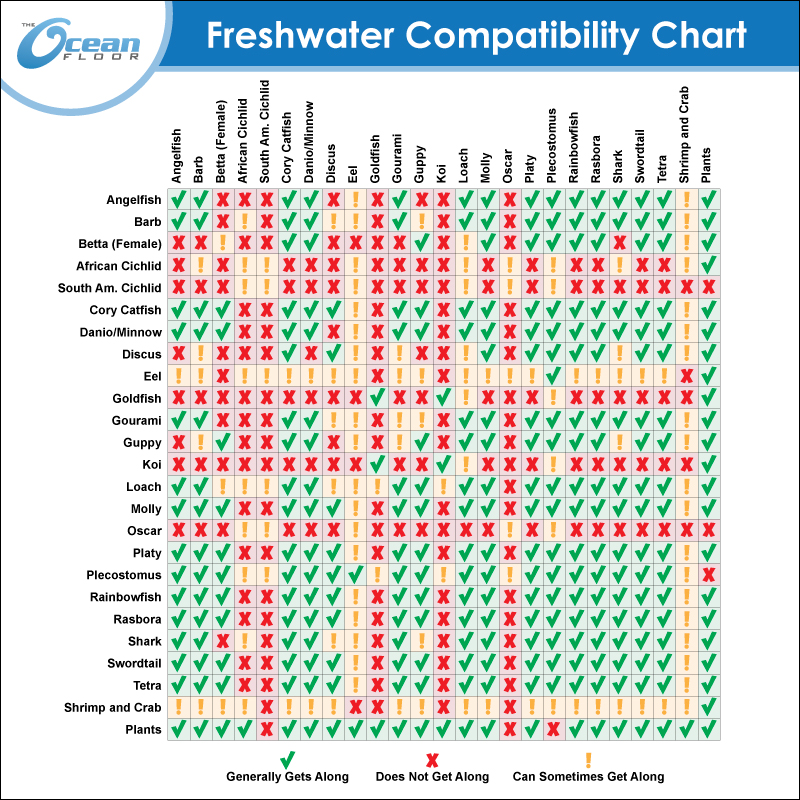If you’re looking to add some more variety to your freshwater aquarium, combing various species of fish is a great way to accomplish this. However, you’ll want to make sure those combinations can peacefully live together. Selecting fish species that get along can be a challenge every aquarium owner faces. Even though there are certain fish combinations we know with near certainty will or will not work in many instances, there are a multitude of others that can go either way depending on a variety of circumstances.
When looking for fish to combine, here are some topics we’ll cover:
Table of Contents
Environment:
- Aquarium Size
- Aquarium Dimensions
- Quantity Fish
Types of Fish:
- Species of the Fish
- Fish Age
- Fish Size
- Fish Gender
- Territory/Dominance Hierarchies
- Predatory Fish
Other Considerations:
- Decorations and Plants
- If Fish Are Breeding
- Fish Personalities
Aquarium Considerations
There are numerous factors to consider when choosing your aquarium, accessories and decor.
Aquarium Size
Every fish will need some amount of space to be content, and the more space a fish has, the more likely they are to get along. The reason is, when fish are crowded together, they become more agitated and anxious and are therefore more likely to fight with their tank mates.
A commonly used rule for stocking an aquarium is one inch of adult size fish per net gallon of aquarium capacity. However, territorial fish will need even more space. It is also important to remember the fish you buy will probably grow a bit, and a 40-gallon aquarium doesn’t truly hold 40 gallons of water when you consider such elements as internal dimensions, gravel, and plants or decorations.
What also may seem like a large aquarium to us (for example more than 200 gallons), is still a small fraction of the space a fish would typically have access to in their natural habitat.
Aquarium Dimensions
Different fish species prefer different shaped aquariums and swimming spaces. For example, a wider aquarium gives active fish like the Danio and Barb the space to spread out, which as mentioned in the previous paragraph, helps them get along better. Conversely, a tall and narrow aquarium fits better into narrow spaces but doesn’t offer as much swimming area or territory as a wider aquarium, so these aquariums are best used for less active species like the Discus, Angelfish, and Gourami. Check out our aquarium offerings.
Fish Considerations
When planning the environment for a combination of freshwater fish varieties, consider these issues:
Quantity of Fish
Some freshwater species, such as Tiger Barbs, Tetras, and Danios can be a little boisterous at times but tend to behave better when in large schools. Schooling fish are also less likely to be picked on when kept in large numbers. The best practice for purchasing schooling fish is to buy them in groups of six or more. This deters the dominant fish from singling out the weaker/submissive fish.
Species of the Fish
Freshwater fish species, just like all animals, communicate in a variety of ways. These fish signals can sometimes be misinterpreted by other fish in the aquarium because fish from different parts of the world sort of speak different languages. It is important to research the fish species you are considering before trying to stock your aquarium with them.
Cichlids, Loaches, Knife Fish, and other territorial fish do not often share aquarium space well with members of their own kind or closely related fish species. Having a large aquarium with plenty of cover and décor does help, but many of these types of fish are best kept as individuals with tank mates that aren’t similar-looking or closely related.
Asking our fish experts at The Ocean Floor about how to put together a community fish tank with a variety of species is always a good option. For example, finding an appropriate fish compatible with Bettas can be challenging but our experts can help advise you.
Fish Age
The age of a fish is also an important aspect to consider when building a community tank because juvenile fish typically tend to be easier going even if they are known to be aggressive as adults. Young fish can often be mixed with a wider selection of aquarium mates because they’ll be more likely to accept them as they grow and mature. There have been many reports of larger predatory fish coexisting with feeder fish they could easily swallow but don’t because both fish were the same size when introduced, before the predatory fish grew larger and learned to eat other fish.
Fish Size
Most fish will be opportunistic with food. Even a relatively peaceful fish species will try to eat other fish if they think they can. That is why it is best to buy fish that are about the same size as the others in your aquarium. If you are mixing territorial fish species, the new ones should be at least the same size as the largest and most aggressive fish already in the aquarium.
Fish Gender
Although one might not think of it right away, fish gender can also play a role in the ability of fish species to get along in a community aquarium. Male fish have a penchant for being more territorial and aggressive than the females of a fish species, especially when mating. Avoid having more than one male of a similar or closely related territorial species fish within a community, especially if females are present. It is also a good idea to keep live-bearing fish in ratios of 2 to 3 females per male in order to lessen the persistent mating behavior of the males.
Territory and Dominance Hierarchies
Territory and dominance hierarchies are particularly common in the Cichlid community, where pecking orders exist, and a smaller or submissive fish may be picked on and need to be removed for their safety. Removing the aggressive fish is another option, but the next fish in the order may assume the dominant role and continue the cycle of aggression.
Predatory Fish
When someone thinks of a predatory fish, they often thing of a large, aggressive fish like what is found in the Cichlid family, but there are other species of freshwater predators such as Catfish, Arowanas, Leaf Fish, Bichirs, Gar, and more. For species such as these, whatever they can fit in their mouth is fair game. That doesn’t inherently make them aggressive, just hungry.
Decorations and Plants
Many fish need a place to claim as their own, and fish define their personal territory by physical boundaries. They also tend to mind their own business when they can’t see each other. So, aquarium décor such as rocks, caves, driftwood, and other decorations help define territory for freshwater species such as Cichlids and other territorial fish. Tall, bushy plants provide habitat and give schooling fish such as Tetras, Barbs, Danios, and Rasboras their own areas. Visit our supplies page to select items for your freshwater environment.
One way to help deter aggression when introducing new territorial fish to an existing community tank is to add a few new décor items and rearrange existing items in order to eliminate territories controlled by established fish.
Fish Breeding
Just like many animal species across the globe, fish during breeding time can become especially defensive. Fish during breeding time will take over large areas of an aquarium, usually pushing all other tank inhabitants into a corner. It is best to have a dedicated breeding tank in order to mitigate this problem.
Fish Personalities
Although we can observe and make general observations about the behavior patterns of a fish species, there will always be exceptions. The factors mentioned previously can affect fish interaction in an aquarium but fish, like all creatures, will have individual personalities and will sometimes behave in unexpected ways. The best practice is to simply expect the unexpected and separate fish that don’t get along.
Recommended Freshwater Aquarium Fish Combinations:
Although there are a ton of potential freshwater fish combinations, after speaking with our fish experts at The Ocean Floor, we made this list of combinations that have proven to be successful for both owner and fish in order to help you put together your freshwater community aquarium. Peruse our selection of freshwater fish.

1) Apistogramma Dwarf Cichlid and Green Neon Tetra
Apistogramma are stunning and interesting fish that come from South America in the Amazon region. They do great in smaller tanks with warm, soft water with tannins from driftwood and Catappa leaves. Apistogramma have a similar appearance to both African and common South/Central American Cichlids. Unlike many larger Cichlids, they stay very small with the largest varieties rarely growing over 3.5 inches.
There are many different varieties to choose from and they are generally peaceful towards many other types of community fish like Green Neon Tetras. Green Neon Tetras have a beautiful all blue and green hue running across their body. They tend to do better in softer water and the tannins in the water tend to make their color really pop. Green Neon Tetras tend to hang out up top, peacefully darting around, which is a beautiful contrast to the Apistogramma posturing towards each other while inhabiting the structure on the bottom of the tank.
Learn more about Apistogramma in this longer article.

2) African Cichlids and Synodontis Catfish
African Cichlids are very colorful freshwater fish and are often confused with saltwater by the uninitiated because of their striking neon colors. They need lots of filtration due to their voracious and constant appetites.
No fish begs for food or rapidly hunts its down as fast or intensely as African Cichlids. Due to their high aggression levels, it is always best to plan out your tank with these fish, including the flow of water which they will swim against as well as adding at least three (preferably of similar sizes) at one time.
A constantly moving school of colorful Peacock or Mbuna Cichlids from Lake Malawi and Lake Victoria makes for a striking. A good companion for these Cichlids would be the various Synodontis Catfish which comb the bottom in search of food. With many different dark patterns over tan, grey, and brown with impressive natural fins, they are a beautiful and interesting contrast to the Cichlids. Not only do they keep the bottom clean, but they can also tolerate the aggression of the African Cichlids in a way many other fish cannot.

3) Rainbow Shark and Tiger Barbs
Rainbow Sharks are all black with bright red fins and a torpedo-like body. They get reasonably large but can still be kept in medium size aquariums successfully. Rainbow Sharks do best in groups of three or more, often filling the bottom and middle portions of the aquarium, searching for food methodically in contrast to a rapidly swimming school of Tiger Barbs.
Tiger Barbs will typically inhabit the middle to upper regions of the tank but are not afraid to go low in search of food. Being voracious and semi-aggressive, they should not be kept with most Tetras except the larger, more robust varieties. A school of Tiger Barbs is striking with so much movement and their unique triangular body shape.
Building your school with different varieties such as platinum and regular green, red albino, and common Tiger Barbs makes for an interesting and colorful display to contrast the red and black Rainbow Sharks. As with most fish, adding groups of three or more is heavily recommended with Tiger Barbs.

4) Guppies and Cherry Barbs
Guppies are live-bearing fish that come in many different colors and shapes. Adapting to a wide variety of water parameters, they do great in Phoenix tap water and benefit tremendously from a little salt. They enjoy medium water temperatures and are easy to propagate and build a school with many different color varieties to choose from.
It is recommended to add both Guppies and Cherry Barbs in groups of three or more with two females to every male to reduce and contain aggression. The bigger the school the better. Cherry Barbs are smaller, peaceful community Barbs that dart around the tank in search of bits of food.
Their differing swimming tendencies and body shape make for an interesting contrast. The bright red males and gold females add a colorful and natural look to your aquarium which also contrasts nicely with live plants.

5) Discus, Rummy Nose Tetra, and Cardinal Tetra
All three of these gorgeous fish come from the same part of the world in South America in the Amazon region. They do best in medium to large aquariums enjoying softer, warm water with lots of tannins. These fish look amazing together and get along well. Seeing a beautiful school of Rummy Nose and Cardinal Tetras dart around the tank in search of bits of food is always a beautiful sight. In water with heavy tannins, they often appear to glow.
Tetras tend to swim against the current which is great because you can manipulate how and where they swim with the flow of water. In contrast, Discus typically avoid direct current and search for comfortable places to spend their time.
Discus tend to hold their positions while making slower movements and posturizing towards each other. The Discus generally leave the Tetras alone and the Tetras tend to pick up scraps of food that the Discus miss. This combination creates an ideal contrast and a freshwater tank that appears to be bursting with life and beautiful colors.

6) Managuense Cichlid, Red Hook Silver Dollar, and Pictus Catfish
Managuense Cichlids are beautiful black, brown, and gold in color and are often compared to Largemouth Bass because of their similar appearance. They make great aquarium pets in larger aquariums of at least 90 gallons or more. They can get up to a foot in length and make a great center-piece fish that will capture people’s attention. They need lots of filtration in general and tend to make a mess when they eat.
This is where the dither fish and bottom-feeding fish come in. The very active and striking Pictus Catfish is a great bottom feeder. Pictus Catfish are silver and white with interesting patterns of black to grey that cover much of their body. They have very long whiskers they use to comb the bottom for scraps of food. Because of their sharp spines, most Cichlids will not try to eat them. They tend to stay in the lower regions of the aquarium except in some cases when feeding. Pictus Catfish are also very fast swimmers that appear to be constantly moving, which is a nice contrast to a large Managuense which often maintain positions for some time.
A nice school of at least three or more Red Hook Silver Dollars act as the dither fish inhabiting the upper portions of the tank. They not only pick off scraps from the Managuense, but they are also not easily eaten because of their very widebodies and fast swimming abilities.
If none of the combinations above strikes your interest, we also have this handy compatibility chart to get you started.


